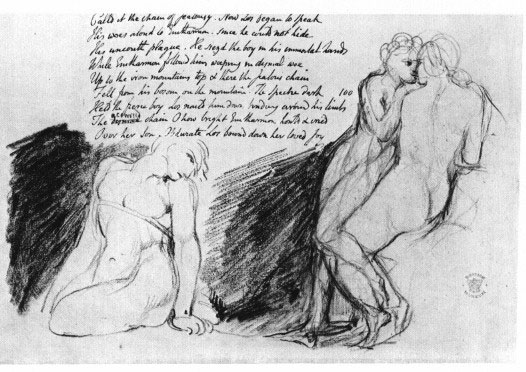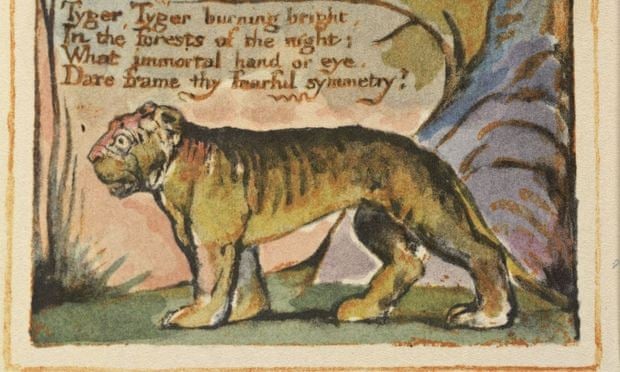In 1789, William Lisle Bowles (1762-1850) wrote an influential sonnet sequence, Fourteen Sonnets, a sign of brighter times ahead for the form. As rational, witty, neoclassical seventeenth century poems written in heroic couplets gave way to major works in more open forms, the sonnet was somehow adapted to accommodate the literary values of this period. In many of these works one can sense the new worth placed on intuition and spontaneity.
Second, perhaps, only to Shakespeare, William Wordsworth (1770-1850) is generally considered one of the greatest sonneteers. Writing over five hundred sonnets (mostly the early ones are still read), he ushered the form back into widespread use and also revived the sonnet sequence. Wordsworth continued the work of Milton
When I first Married you, I gave you all my whole Soul
Among the well known poets of the Romantic period, John Keats (1795-1821) and Percy Shelley (1792-1822) wrote the sonnets most commonly anthologized--"Bright Star" and "Ozymandius", respectively. Other notable poets, including Samuel Taylor Coleridge (1772-1834) and Lord Byron(1788-1824), wrote a few sonnets but did their best work in other forms.
Here, perhaps even more than elsewhere, the chronological division of sonneteers is arbitrary, with Thomas Hood chosen as the Victorian to begin the next section. Also, a few of the earlier poets here might have been more comfortable in the diverse Sonnet Central group preceding.
William Blake (28 November 1757 – 12 August 1827) was an English painter, poet and printmaker.William Blake was born at 28a Broad Street, Golden Square, London on the 28th of November 1757. His father was a hosier, and the family was comfortable and middle class. From an early age William showed a head-strong, independent nature, and perhaps it was due to his unusual personality that his parents decided not to try and confine William to any kind of formal education. It seems his mother was happier with this arrangement than his father, who sometimes lost patience with their son. When at about the age of eight, William returned home and announced that he had seen angels hanging in the branches of a tree, James Blake was ready to try beating such notions out of the boy, and was only restrained by his wife. So William continued to go his own way, seeing his visions, thinking his intense thoughts, and reading the Bible, a book which was to have a profound and lifelong influence on him.
In August 1772 Blake became an apprentice to an engraver named James Basire. Basire's
premises were at 31 Great Queen Street, London. The building no longer survives, but the
London. The building no longer survives, but the
brick houses on either side give an idea of how it would have appeared. Blake worked here

for seven years, until he left aged twenty one to become a professional engraver. While Blake
The Blake Society is launching a crowd-funding campaign in September to raise money to buy the former country home of William Blake. The quaint Grade-II-listed thatched cottage at Felpham in Sussex has been on the market for £650,000. It is where Blake wrote the poem for the hymn “Jerusalem”, and Felpham is where he was arrested for sedition.
was training he was deeply affected by a task of engraving images at Westminster
Abbey. While engaged in this work there is a record of an incident involving a boy from Westminster School. This boy is supposed to have "tormented" Blake to the point where Blake pushed the boy off a scaffold to the ground. Largely unrecognised during his lifetime, Blake is now considered a seminal figure in the history of the poetry and visual arts of the Romantic Age. His prophetic poetry has been said to form "what is in proportion to its merits the least read body of poetry in the English language". His visual artistry led one contemporary art critic to proclaim him "far and away the greatest artist Britain has ever produced". In 2002, Blake was placed at number 38 in the BBC's poll of the 100 Greatest Britons.
His visual artistry led one contemporary art critic to proclaim him "far and away the greatest artist Britain has ever produced". In 2002, Blake was placed at number 38 in the BBC's poll of the 100 Greatest Britons.
Although he lived in London his entire life (except for three years spent in Felpham), he produced a diverse and symbolically rich oeuvre, which embraced the imagination as "the body of God" or "human existence itself".
he produced a diverse and symbolically rich oeuvre, which embraced the imagination as "the body of God" or "human existence itself".
 .
.
Blake's attacks on conventional religion were shocking in his own day, his rejection of religiosity was not a rejection of religion per se.
"Prisons are built with stones of Law, Brothels with bricks of Religion.
As the caterpillar chooses the fairest leaves to lay her eggs on, so the priest lays his curse on the fairest joys."
Second, perhaps, only to Shakespeare, William Wordsworth (1770-1850) is generally considered one of the greatest sonneteers. Writing over five hundred sonnets (mostly the early ones are still read), he ushered the form back into widespread use and also revived the sonnet sequence. Wordsworth continued the work of Milton
When I first Married you, I gave you all my whole Soul
I thought that you would love my loves & joy in my delights
Seeking for pleasures in my pleasures, O Daughter of Babylon
Then thou wast lovely, mild & gentle, now thou art terrible
In jealousy & unlovely in my sight, because thou hast cruelly
Cut off my loves in fury till I have no love left for thee.
Thy love depends on him thou lovest & on his dear loves
Depend thy pleasures which thou hast cut off by jealousy.
Milton (1804-10) in freeing the sonnet's subject matter from the conventional and treated the sonnet as a subjective "verse essay" in which to explore his emotions (White & Rosen).Seeking for pleasures in my pleasures, O Daughter of Babylon
Then thou wast lovely, mild & gentle, now thou art terrible
In jealousy & unlovely in my sight, because thou hast cruelly
Cut off my loves in fury till I have no love left for thee.
Thy love depends on him thou lovest & on his dear loves
Depend thy pleasures which thou hast cut off by jealousy.
Among the well known poets of the Romantic period, John Keats (1795-1821) and Percy Shelley (1792-1822) wrote the sonnets most commonly anthologized--"Bright Star" and "Ozymandius", respectively. Other notable poets, including Samuel Taylor Coleridge (1772-1834) and Lord Byron(1788-1824), wrote a few sonnets but did their best work in other forms.
Here, perhaps even more than elsewhere, the chronological division of sonneteers is arbitrary, with Thomas Hood chosen as the Victorian to begin the next section. Also, a few of the earlier poets here might have been more comfortable in the diverse Sonnet Central group preceding.

William Blake (28 November 1757 – 12 August 1827) was an English painter, poet and printmaker.William Blake was born at 28a Broad Street, Golden Square, London on the 28th of November 1757. His father was a hosier, and the family was comfortable and middle class. From an early age William showed a head-strong, independent nature, and perhaps it was due to his unusual personality that his parents decided not to try and confine William to any kind of formal education. It seems his mother was happier with this arrangement than his father, who sometimes lost patience with their son. When at about the age of eight, William returned home and announced that he had seen angels hanging in the branches of a tree, James Blake was ready to try beating such notions out of the boy, and was only restrained by his wife. So William continued to go his own way, seeing his visions, thinking his intense thoughts, and reading the Bible, a book which was to have a profound and lifelong influence on him.

In August 1772 Blake became an apprentice to an engraver named James Basire. Basire's
premises were at 31 Great Queen Street,
 London. The building no longer survives, but the
London. The building no longer survives, but thebrick houses on either side give an idea of how it would have appeared. Blake worked here


for seven years, until he left aged twenty one to become a professional engraver. While Blake
The Blake Society is launching a crowd-funding campaign in September to raise money to buy the former country home of William Blake. The quaint Grade-II-listed thatched cottage at Felpham in Sussex has been on the market for £650,000. It is where Blake wrote the poem for the hymn “Jerusalem”, and Felpham is where he was arrested for sedition.
was training he was deeply affected by a task of engraving images at Westminster
Abbey. While engaged in this work there is a record of an incident involving a boy from Westminster School. This boy is supposed to have "tormented" Blake to the point where Blake pushed the boy off a scaffold to the ground. Largely unrecognised during his lifetime, Blake is now considered a seminal figure in the history of the poetry and visual arts of the Romantic Age. His prophetic poetry has been said to form "what is in proportion to its merits the least read body of poetry in the English language".
 His visual artistry led one contemporary art critic to proclaim him "far and away the greatest artist Britain has ever produced". In 2002, Blake was placed at number 38 in the BBC's poll of the 100 Greatest Britons.
His visual artistry led one contemporary art critic to proclaim him "far and away the greatest artist Britain has ever produced". In 2002, Blake was placed at number 38 in the BBC's poll of the 100 Greatest Britons.
Although he lived in London his entire life (except for three years spent in Felpham),
 he produced a diverse and symbolically rich oeuvre, which embraced the imagination as "the body of God" or "human existence itself".
he produced a diverse and symbolically rich oeuvre, which embraced the imagination as "the body of God" or "human existence itself".
Although Blake was considered mad by contemporaries for his idiosyncratic views, he is held in high regard by later critics for his expressiveness and creativity, and for the philosophical and mystical undercurrents within his work. His paintings and poetry have been characterised as part of the Romantic movement and as "Pre-Romantic"
 .
.
Reverent of the Bible but hostile to the Church of England (indeed, to all forms of organised religion), Blake was influenced by the ideals and ambitions of the French and American Revolutions
Though later he rejected many of these political beliefs, he maintained an amiable relationship with the political activist Thomas Paine; he was also influenced by thinkers such as Emanuel Swedenborg.
Despite these known influences, the singularity of Blake's work makes him difficult to classify. The 19th-century scholar William Rossetti characterised him as a "glorious luminary", and "a man not forestalled by predecessors, nor to be classed with contemporaries, nor to be replaced by known or readily surmisable successors".

Blake's attacks on conventional religion were shocking in his own day, his rejection of religiosity was not a rejection of religion per se.
"Prisons are built with stones of Law, Brothels with bricks of Religion.
As the caterpillar chooses the fairest leaves to lay her eggs on, so the priest lays his curse on the fairest joys."
I
No comments:
Post a Comment